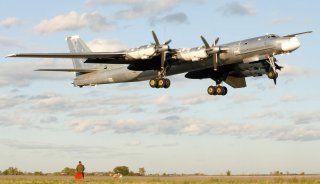Yes Russia's Old (But Upgraded) Tu-95 Bombers Still Matter
They pack a nuclear punch.
Key point: This bomber is important to Russia's strategic forces. It might still be propeller-driven, but don't let that fool you.
The Tu-95 is one of the oldest designs in active service in the Russian Air Force. Driven by eight contra-rotating turboprop engines, it is the only propeller-powered bomber that remains in service today. It shows no signs of leaving service either, with the Russian Air Force rolling out the Tu-95MSM modernization that adds significant capability to the Tu-95, far beyond its original role of dropping unguided bombs.
This first appeared in 2019 and is being reposted due to reader interest.
The current backbone of the Russian strategic bomber force is the Tu-95MS. While the main purpose of the Tu-95MS variant was to integrate new air-to-surface missiles into the Tu-95, this was a continuation of an existing trend. The Soviet Union experimented with air-to-surface missiles on Tu-95s starting in the 1950s, with the Tu-95K. This continued throughout the Cold War, culminating in the Tu-95MS series in 1981. The Tu-95MS series was a deep modernization of earlier versions of the Tu-95, replacing a myriad of equipment: everything from the defensive guns to the radars. The purpose was to create a new strike variant of the Tu-95 that could be used to launch new longer ranged air-to-surface cruise missiles. Due to the older Tu-95 airframes not being suitable for modernization, production lines for the Tu-95 were actually restarted in the 1980s to produce the new Tu-95MS variants, so those flying today are relatively young compared to some NATO aircraft.
The Tu-95MS’s primary armament is the Kh-55 air launched cruise missile (ALCM). The Kh-55 is a subsonic missile with a range of around 2500 km. The current fielded nuclear armed missile is the Kh-55SM, which increases the range of the Kh-55 to 3500 km. Its conventionally armed counterpart is the Kh-555, with a range of 2000 km. The Kh-555 has seen use in Syria fired from Tu-95MS. The regular Tu-95MS6 carries six of these internally in a KMU-6-5 rotary launcher. The modernized Tu-95MS16 adds external pylons for an additional ten missiles, bringing the total up to sixteen. According to the 2018 Nuclear Notebook report by the Bulletin of Atomic Scientists, the Russian Air Force currently fields 25 Tu-95MS6 and thirty Tu-95MS16. The report doesn’t list any numbers for the new Tu-95MSM modernization, but estimates that only a “few dozen . . . perhaps around 44” will be modernized.
The primary purpose of the Tu-95MSM modernization is to give the Tu-95MS the ability to fire the Kh-101 and Kh-102 cruise missiles that are carried by the newer Tu-160 bomber. Because of the increased length of the missile, the Kh-10(X) cannot be carried on the internal rotary launcher of the Tu-95MS. As such, the Tu-95MSM adds four additional external pylons which can carry two missiles each. Two pylons are placed to either side between the fuselage and the innermost engine. The other two are placed between on either side between the innermost and outermost engines. These pylons are compatible with the new missiles and all prior Kh-55 missiles. The Kh-101 and Kh-102 represent a significant increase in capability as they are longer ranged (up to 5000km), and are less detectable on radar. The Kh-101 was also launched at targets in Syria on November 17, 2015, from a Tu-160 carrier aircraft. It has seen continued use in that theater since then.
In addition to the ability to carry Kh-10(X) missiles, the Tu-95MSM has frame improvements, strengthening the wing so the new missiles can be carried safely. Other sources report that revised engines and propellers are also part of the upgrade, granting increased flight performance. As the current engines that are used in the Tu-95MS are no longer in production, this would enhance the ability for the fleet to get spare parts and maintenance. New radars and data display systems are also included in the modernization.
What’s interesting about the Tu-95MSM modernization is that it represents a slow downsizing of the Russian strategic bomber fleet. Both the BAS and popular Russian sources have suggested that the MSM upgrade will not be applied to the entire current Tu-95MS fleet. Along with the slow-but-limited production of Tu-160s, the Russian bomber fleet is looking to shrink up until the introduction of the new PAK-DA bomber. This is occurring concurrently with an apparent emphasis on land-based ICBMs, as recently various programs to provide Active-Protection Systems for ICBM silos have been receiving attention. The MSM upgrade can also be seen as conventionally focused, as the Tu-95 fleet has been seen training for that role and the Kh-101 will add significant amounts of additional standoff range and accuracy for use in conventional conflict.
Charlie Gao studied political and computer science at Grinnell College and is a frequent commentator on defense and national-security issues. This first appeared in 2019 and is being reposted due to reader interest.
Image: Reuters

